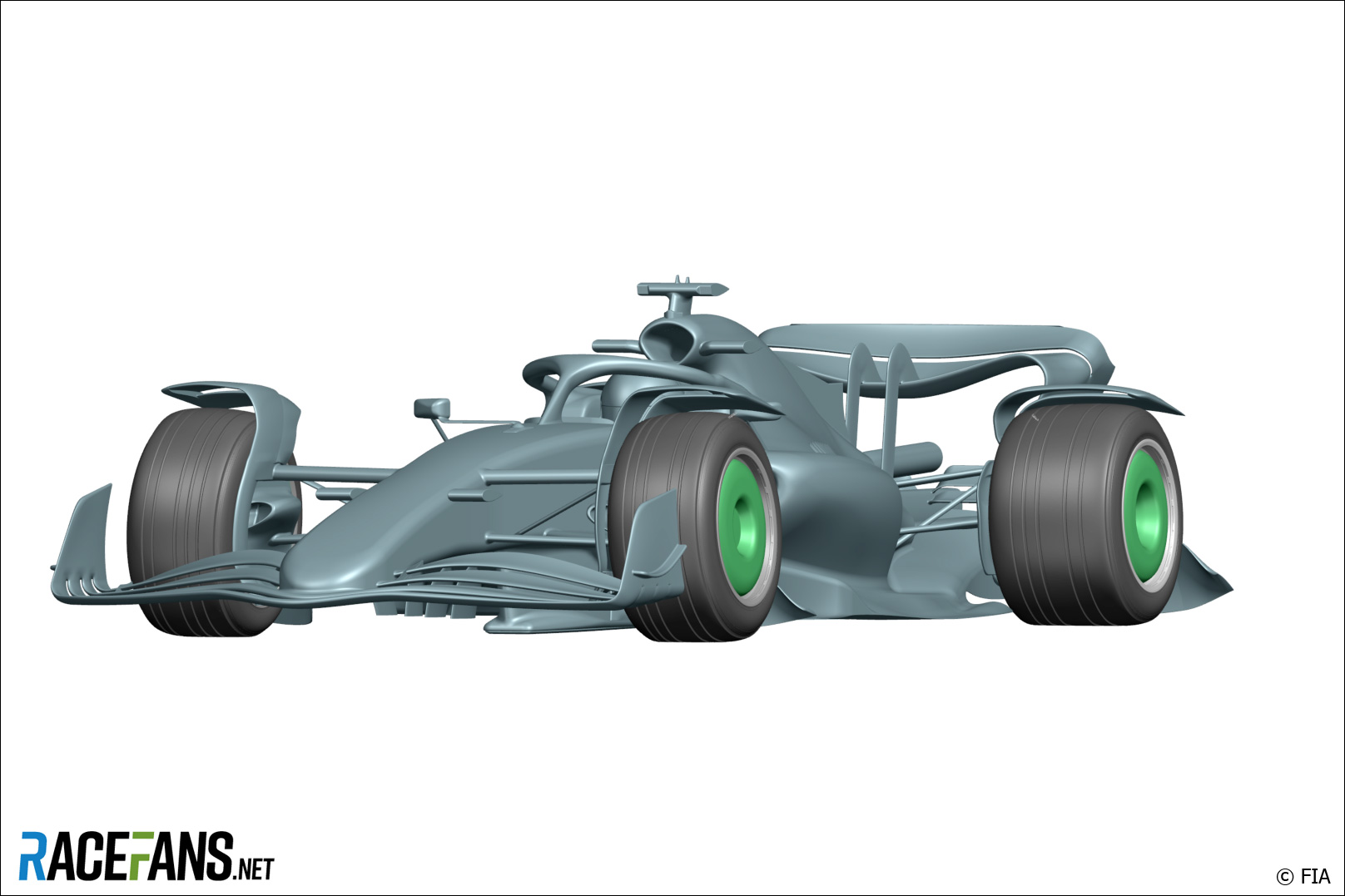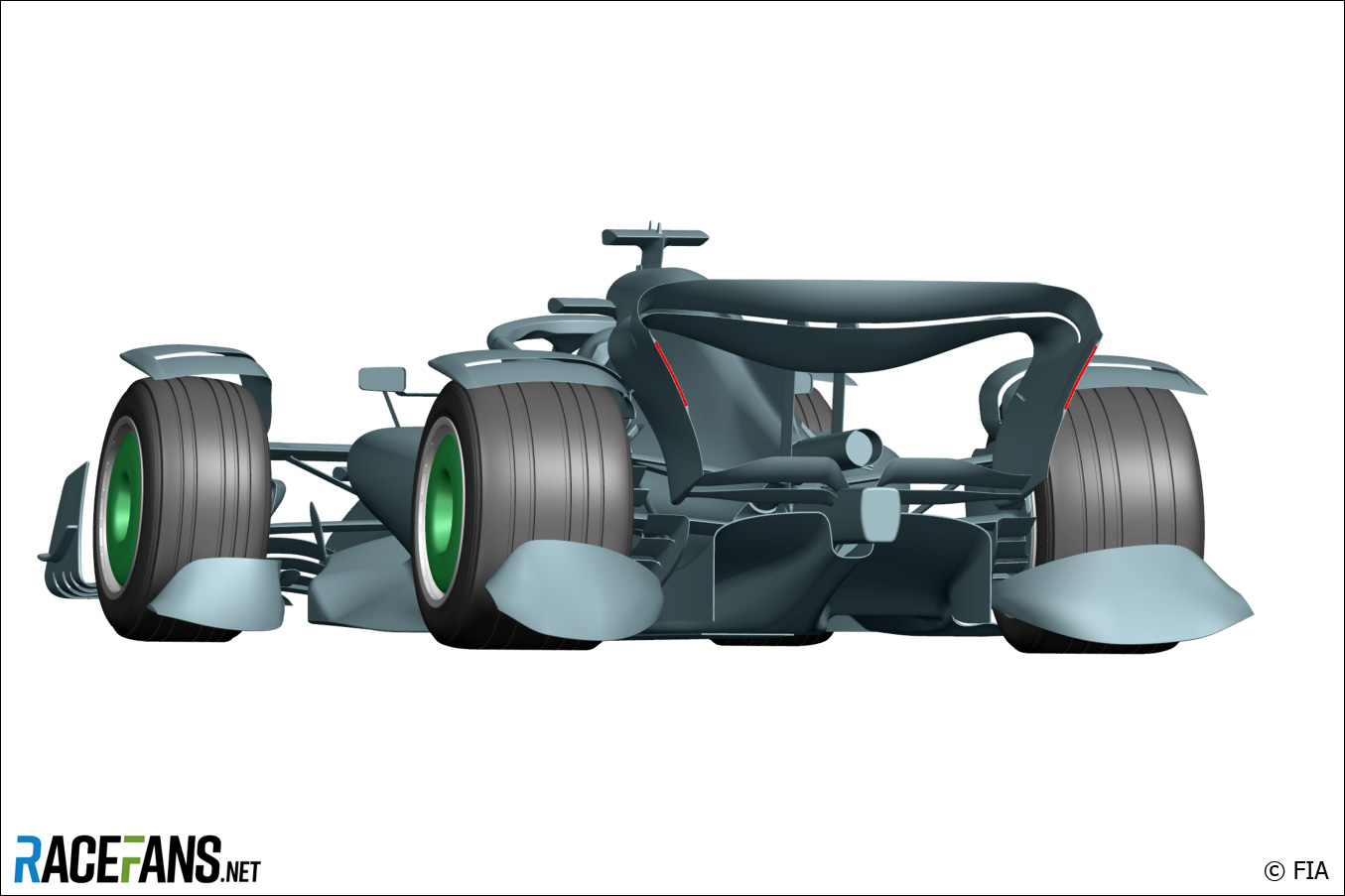The FIA has issued images of the ‘spray guard’ design it is testing as it seeks to improve the visibility problems drivers encounter in wet races.
The problem has become especially severe in Formula 1 where several races have been disrupted by poor weather in recent years. The Japanese Grand Prix at Suzuka was disrupted by a downpour last year and in 2021 the Belgian Grand Prix was abandoned after just three laps behind the Safety Car due to persistent heavy race at Spa-Francorchamps.The FIA is seeking a solution which can also be used in junior categories of single-seater racing. The danger of racing in wet conditions was highlighted in a crash at Spa three weeks ago which claimed the life of Dilano van ‘t Hoff.
FIA president Mohammed Ben Sulayem announced last year the governing body had begun investigating whether a bodywork package could be added to F1 cars in wet races to reduce the spray they generate and improve visibility. Mercedes and McLaren participated in the first track test of the design at Silverstone last week.
The bodywork is installed behind and above each of the car’s four wheels. It is intended to cut the amount of water thrown into the air by car tyres, which can displace huge volumes of water on a wet track.
While teams have welcomed the FIA’s efforts to improve safety in wet conditions, Mercedes’ trackside engineering director Andrew Shovlin said the first test indicates more work is needed on the design.
“They’re not ready to be moved into production and regulation at the moment so there’s definitely work to do,” he said.
“They do improve the spray that you get from the tyres, but you still get a lot coming from the diffuser and the way that the rear wings are pulling it up.”
Advert | Become a RaceFans supporter and

Bringing the F1 news from the source
RaceFans strives to bring its readers news directly from the key players in Formula 1. We are able to do this thanks in part to the generous backing of our RaceFans Supporters.
By contributing £1 per month or £12 per year (or the equivalent in other currencies) you can help cover the costs involved in producing original journalism: Travelling, writing, creating, hosting, contacting and developing.
We have been proudly supported by our readers for over 10 years. If you enjoy our independent coverage, please consider becoming a RaceFans Supporter today. As a bonus, all our Supporters can also browse the site ad-free. Sign up or find out more via the links below:
2023 F1 season
- FIA president cleared of alleged interference in two 2023 races
- First week viewing figures for new Drive to Survive season fall again
- Max who? Drive to Survive season six prefers its favourite faces
- RaceFans’ complete 2023 season review
- The F1 drivers who pulled off the 10 biggest charges through the field in 2023





paulipedia (@paulipedia)
22nd July 2023, 14:18
Not sure how this would work. Would you start a dry race this way with rain expected and then the rain doesn’t come.
Sihrtogg (@sihrtogg)
22nd July 2023, 14:28
Yes you got it!
I could also see a red flag being thrown to allow them to be fitted. This of course will make the racing much safer.
SjaakFoo (@sjaakfoo)
22nd July 2023, 14:32
I mean, you could probably just make them easily attachable and removable and have them fitted or removed during pit stops when you switch from dry to wet tires.
GT Racer (@gt-racer)
22nd July 2023, 14:45
@paulipedia @sihrtogg @sjaakfoo As of the last I heard if a race starts dry & it subsequently rains then it would be red flagged in order for teams to be able to install the spray guards. Once all cars still running have confirmed they have been fitted there would be at least an additional 10 minute wait until the race would be restarted with a standing grid re-start.
If the rain stops & track dries the guards would be left on the cars until the end of the race.
They apparently take a few minutes to be bolted on which is why it isn’t something that can simply be done during a pit stop. I also gather that should one suffer damage that car would be required to pit to replace it.
anon
22nd July 2023, 14:51
@paulipedia the information given so far is that it would be up to race control to decide when the spray guards should be fitted. However, the most probable scenario is that the spray guards would be fitted if heavy rain is already falling before the start of the race, given that’s when the cars are at their closest and visibility likely to be at it’s worst.
Once the guards are fitted, the expectation is that the guards would remain fixed on the car until the end of the race (i.e. since the guards will probably need to be mounted onto a hard point on the car, such as onto the suspension, to withstand the loads acting on them, which means it probably would not be a quick process to remove the guards).
MEGATRON M12 (@megatron)
22nd July 2023, 15:26
Looks like a debris field ready to happen.
OOliver
22nd July 2023, 17:06
What next perhas bumpers and turning indicators.
J Soulsby (@jmsoulsby)
22nd July 2023, 21:45
LOL
Stephen Crowsen (@drycrust)
22nd July 2023, 22:42
I think the guards need to be tapered more to reduce the turbulence behind the wheels, especially behind the rear wheels.
Antz (@antznz)
23rd July 2023, 8:17
There’s a lot of considerations the more i think about these. Are they standard parts or teams design their own? If they’re standard that has aerodynamic implications or if teams design them they’ll be treated primarily as aerodynamic devices and mitigate the effectiveness of their intended purpose. I like the idea. They look interesting. We probably need them.
Stephen Crowsen (@drycrust)
23rd July 2023, 8:57
@antznz I think they are interesting too. I believe they could make the car go faster, reduce the turbulence behind a car, and maybe even reduce the downforce required from the regular aerodynamic features. I hope the FIA allows the teams to have a choice of their own design or the FIA’s design.
AndrewT (@andrewt)
23rd July 2023, 10:05
Gen1 and Gen2 Formula-E cars had permanent wheel guards, where the predominant aim was to minimize the disadvantage of closely following a car in front, but also served well during the few wet races. Obviously they weren’t robust enough to always bear the argy-bargy nature of FE racing, but F1 racing gets less physical in this regard.
Stoo (@stewart51)
23rd July 2023, 14:33
They would also keep the water on the track surface longer than would normally be the case as the wet tyres do lift off the racing line pretty well so it can disperse into the surrounding areas.
So it might be good for drivers following closely behind others, but it would keep them on the wet tyres longer !
AJ
24th July 2023, 20:44
i guess we will have to see real world results. i imagine it wont make any difference. road cars on a highway are completely covered and the amount of spray at normal highway speeds is massive. Imagine at an average of 150 mph.
MCG (@malrg)
31st July 2023, 9:37
I see a bit of a quandary here, if these devices are stopping water from spraying up into the air, where is the water going?
I suspect, back onto the track, so while visibility may be improved, there will be more water on the track and it won’t dry out as fast from cars spraying the water up in the air to evaporate or be blown off the track/racing line…
I’m am only surmising this of course, I don’t actually know.
MCG (@malrg)
31st July 2023, 9:40
and if they move the water off to the sides, anyone trying to overtake is going to be doing so on an even wetter line.